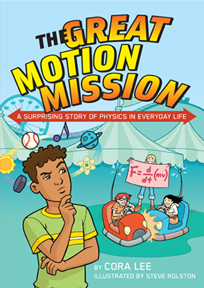| ________________
CM . . .
. Volume XVI Number 24. . . .February 26, 2010
excerpt:
The Great Motion Mission is a fictional story about Jeremy, a boy who might be in grade 9 or 10 and who is ready for summer vacation. However, this particular summer will be like no other. His best friend, Sam, who lives next door, is off to math camp all summer, and Jeremy is not interested in wasting his summer learning math. Sam's parents have an exchange student staying with them while Sam is away. Her name is Audrey, and, although she looks like a typical girl, she has a passion for physics and sees physics as being just about everything. Jeremy has been instructed to include Audrey in his summer plans so that she does not feel like an outsider. Finally, there is Uncle Liam, Jeremy's uncle, who lives in Jeremy's basement. He is a newspaper reporter who is very opinionated. Uncle Liam has been told by the newspaper to report on a conference being held at the local university, the XIV Symposium on the Universality of Physics. This conference is to replace the annual summer fair held in the community, but Uncle Liam has a "phobia when it comes to physics" and is going to try and do everything possible to cancel the conference with Jeremy's help. Jeremy finds himself caught as a double-agent - attempting to assist Uncle Liam with cancelling the conference and then being encouraged by Audrey to help foil Liam's plan so that the conference can go ahead. During the time leading up to the conference, Jeremy, Audrey, Uncle Liam and other friends play sports, visit an art gallery, speak with a musician and discuss fair rides. Each of these "non physics' appearing activities is decoded by Audrey as applications of various real-world occurrences of physics laws and principles. In the end, the conference was a huge success - for physicists that attended, school age children, and those who had little background in physics. Jeremy learned a lot about how physics impacts his life and the world around him in many different ways. He also learned that he may not understand everything that a physicist says, but it is sure nice when you can understand bits and parts. The plot of The Great Motion Mission is interesting from a science education point of view, but young readers may become disinterested in the story as every chapter seems to follow a similar format, i.e., the characters embark on an activity or adventure; there is an assumption that no physics is taking place; and then Audrey gives the explanation of the occurrence as it pertains to the laws and concepts of physics. At no time is Audrey truly challenged or does Jeremy "figure it out on his own." The physics concepts and application of real world physics to the various scenarios are true, accurate and age appropriate. The illustrations and color coding of the key terms are also outstanding. This color coding is also present in the glossary which most students should find useful. The 'further reading' section is also very reasonable and useful for the adolescents whose interest has been sparked by physics and its application to the real world. Although this text could be read by a young reader for 'fun,' I also think that certain elements of the text could be assigned as supplemental reading material for high school physics curricula as the contents of the text are common to various provincial physics curricula. Alternatively, the physics or science teacher could read a section of the text to students that would pertain to the topic being studied to intrigue student interest and open up a discussion concerning the content and context. Finally, the text could be used as an exemplar for a culminating activity in the area of physics, i.e., students could use the model of the text to then explain everyday phenomena in both physics and plain language terms to a younger audience. Recommended. Katarin MacLeod is an Assistant Professor in Science Education at St. Francis Xavier University in Antigonish, NS. Her areas of interest include physics educational research (PER), and the incorporation of science, technology, society and environment (STSE) outcomes into science courses at all levels to help students understand the relevancy of science, increase scientific literacy, and to promote citizenship.
Copyright � the Manitoba Library Association. Reproduction for personal use is permitted only if this copyright notice is maintained. Any other reproduction is prohibited without permission.
NEXT REVIEW | TABLE OF CONTENTS FOR THIS ISSUE - February 26, 2010. AUTHORS | TITLES | MEDIA REVIEWS | PROFILES | BACK ISSUES | SEARCH | CMARCHIVE | HOME |
